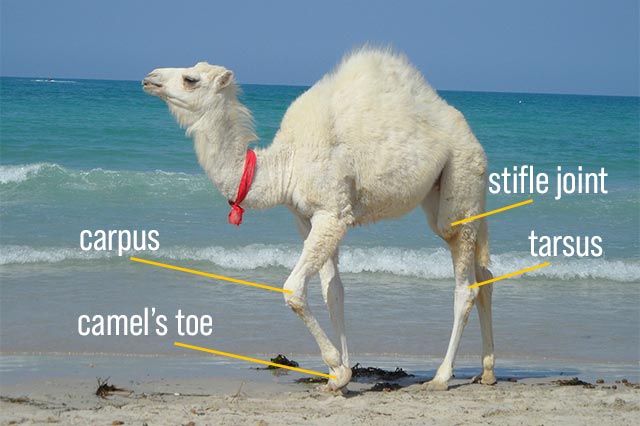A camel has 4 legs, a pair of front, and a pair of back legs. Its limbs are long and skinny, and strong enough to bear the heavy weight of the camel body.
Camels are even-toed ungulates, which means that they bear the weight equally on two toes: the third and fourth.
They have a digitigrade stance, large feet to support the animal in soft sand, and soles of flexible pads that allow the camel to easily walk in the desert. [1]

How Do Camel Legs Look Like?
Camel’s legs are elongated limbs that allow the animal to walk. Each foot has two toes, and at the bottom of the feet, there are large leathery sole pads around 7 inches wide (18 cm). The front legs are shorter than the back legs of camels.

Camel’s feet are split in half and those parts are then joined underneath by webbing to prevent the animal from sinking into the sand.
At the bottom of their feet, there is a protective sole, and inside their feet, towards the heel, there is a thick ball of fat.
Each toe has a toenail at its top.
Camel front leg bones include:
- Scapula
- Humerus
- Radius
- Carpal bones
- Cannon bone
- Phalanges
Camel back leg bones include:
- Pelvis
- Femur
- Patella
- Tibia
- Tarsal bones
- Cannon bone
- Phalanges
On their back legs, camels have what is called a stifle joint. It is similar to a human knee, and it bends forward.
On their front legs, camels have a joint called carpus, which is similar to a human wrist. This joint is what is usually called the camel’s knee.
Camels have another joint that bends in the opposite direction to a human knee. It is called tarsus and is similar to a human ankle. It is also called the hock. [2]

On their elbows and knees, camels have thick calluses to protect them from hot surfaces when lying down.
There are several muscle groups in camel legs, some of the larger ones are:
- Proximal hindlimb muscles (30% of total muscles)
- Distal hindlimb muscles (4% of total muscles)
- Proximal forelimb muscles (18%)
- Distal forelimb muscles (4%)
Their limb length can vary between the species.
The front legs of dromedary camels are between 54.3 and 59.4 inches long (138-151cm); Bactrian front legs are between 57.8 and 59.8 inches long (147-152 cm).
The back legs of dromedary camels are between 57 and 63.7 inches long (145-162 cm); Bactrian back legs are between 59.8 and 68.9 inches long (152-175 cm).
One misconception people have about camel feet is that they think camels have hooves.
However, camels do not have hooves – they have soft, padded feet, and a toenail at each toe. This toenail is what gives an impression that camels have hooves.
Because of their soft bottom padding, walking on hard roads can cause swollen feet.
Also, sharp objects like nails, wire, glass, thorns can hurt the animal and cause injuries to its footpad.
Their special leg structure allows camels to walk differently from other ungulates.
Camels walk and run by moving same-sided legs forward at the same time, and then moving the other same-sided legs forward at the same time.
Sometimes, camel owners will tie their legs.
Read More: Do ducks have knees?
Why Do They Tie Camel Legs?
Owners tie camel’s legs so it doesn’t wander away in pursuit of food. Usually, after the day is over, camel herders will tie one of their legs, and let them during the night to look for food. Having one of the legs tied stops them from going too far away.
This, however, does not stop them completely from going away. Camels have mastered the art of walking on three legs.
Sometimes, an irresponsible owner will tie both of the animal’s legs, to impede it completely from moving.
Because camels have a good memory and are known to hold a grudge for a long time, the animal might attack the owner to get even with him.
Feel free to read about the aggressive behaviors of camels. Click here to open the article.
Camel Leg Facts
- Camels do not have hooves on their legs, they have padded feet instead.
- Their padded feet allow the camel to walk easily in the desert and not sink into the sand.
- Camels have longer back legs than the front ones.
- They have a stifle joint on their back leg (equivalent to a human knee) and carpus on their front leg (equivalent to a human wrist).
- Camel owners might tie camel’s legs, to prevent it from straying away.
Final Thoughts
There you have it!
The question “how many legs does a camel have” answered in detail.
Camels have 4 legs, two front ones, and two back ones. Their long limbs allow them to move properly on hot desert sand.
Read more: Do camels need to be shoed?
References
[1] Dagg, Anne Innis. “The locomotion of the camel (Camelus dromedarius).” Journal of Zoology 174.1 (1974): 67-78.
[2] Al Mohamad, Zakriya Ali, et al. “Magnetic resonance imaging of the normal dromedary camel tarsus.” BMC Veterinary Research 17.1 (2021): 1-11.